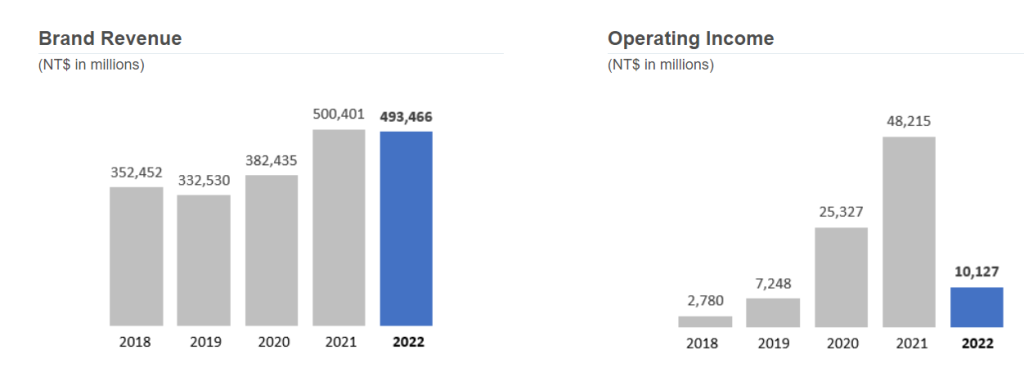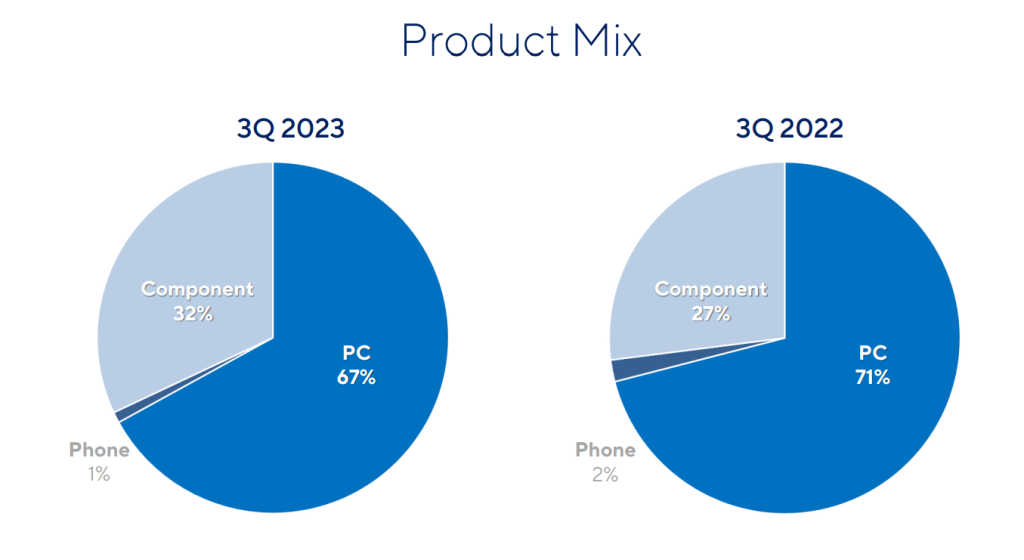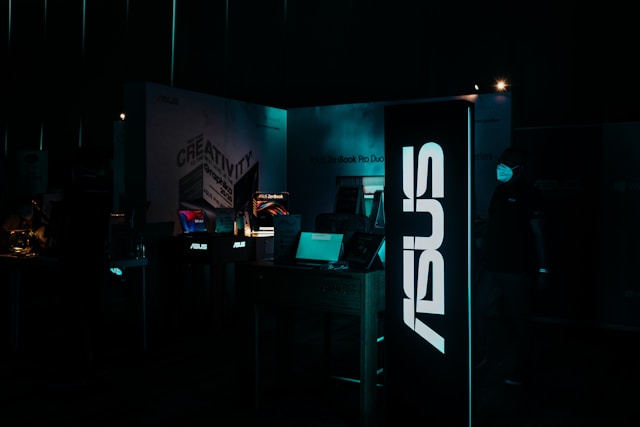Before we dive deep into the SWOT analysis, let’s get the business overview of ASUS. ASUS, or ASUSTeK Computer, is a multinational computer hardware and electronics company headquartered in Taiwan. It’s one of the world’s most prominent PC vendors. It is known for its desktops, laptops, netbooks, mobile phones, networking equipment, monitors, WIFI routers, projectors, motherboards, graphics cards, optical storage, multimedia products, peripherals, wearables, servers, workstations, and tablet PCs.
The company is committed to innovation and quality, winning numerous awards and accolades. ASUS products are designed to cater to a wide range of consumers, including gamers, professionals, and everyday users, focusing on advanced technology, user-friendly design, and reliable performance.
ASUS operates in various business segments, including consumer and commercial markets. It has a significant presence in the gaming industry with its Republic of Gamers (ROG) brand, which is highly regarded by gamers for its high-performance gaming hardware and accessories.
In the commercial sector, ASUS offers a range of products and solutions tailored for businesses of all sizes. These include business laptops, desktops, monitors, and networking solutions designed to meet the demands of modern work environments, emphasizing productivity, flexibility, and security.
ASUS has a global footprint, with a network of offices and service centers across the Americas, Europe, Asia, and Oceania, ensuring widespread availability of its products and support services. The company is also committed to sustainability and corporate social responsibility, with initiatives to reduce its environmental impact and contribute positively to communities worldwide.

Here is the SWOT analysis for ASUS
A SWOT analysis is a strategic planning tool used to evaluate the Strengths, Weaknesses, Opportunities, and Threats of a business, project, or individual. It involves identifying the internal and external factors that can affect a venture’s success or failure and analyzing them to develop a strategic plan. In this article, we do a SWOT Analysis of ASUS.
SWOT Analysis: Meaning, Importance, and Examples
Strengths
- Innovation and R&D: ASUS strongly focuses on research and development, consistently introducing innovative products and technologies. This commitment to innovation helps ASUS stay at the forefront of the industry and meet the evolving needs of consumers and businesses.
- Diverse Product Portfolio: ASUS offers various products, from consumer electronics like laptops, tablets, and smartphones to computer hardware such as motherboards and graphics cards. This diversity allows ASUS to cater to various market segments and customer needs.
- Brand Reputation and Awards: ASUS is recognized for its quality and reliability, winning numerous awards for its products. This reputation for excellence helps build customer trust and loyalty.
- Global Presence: With operations and distribution networks in many countries, ASUS has a solid global presence, enabling it to reach a broad customer base and benefit from diverse market opportunities.
- Strategic Partnerships: ASUS has formed partnerships with various key players in the technology sector, including Intel, Microsoft, and Google. These partnerships have helped ASUS enhance its product offerings and expand its market reach.
- Focus on Gaming Market: ASUS has successfully captured the gaming market with its Republic of Gamers (ROG) brand, known for high-performance gaming laptops, desktops, and accessories. The gaming industry’s growth has further strengthened ASUS’s position in this lucrative market.
- Quality and Design: ASUS highly emphasizes the quality and design of its products, often incorporating unique features and aesthetics that appeal to consumers and set its products apart from competitors.
- Customer Service and Support: ASUS is known for providing effective customer service and support, enhancing customer satisfaction, and improving brand loyalty.
Weaknesses
- Competitive Market: ASUS operates in a highly competitive industry with numerous players, including giants like HP, Dell, Lenovo, and Apple. This intense competition puts pressure on pricing, margins, and market share.
- Dependence on Component Suppliers: The company relies on external suppliers for critical components, such as processors from Intel and AMD or GPUs from NVIDIA and AMD. This dependence can make ASUS vulnerable to supply chain disruptions, component shortages, and fluctuations in component pricing.
- Product Overlap: ASUS’s diverse product lineup, while a strength, can also lead to product overlap, potentially confusing customers and diluting brand identity in specific segments.
- Challenges in the Smartphone Market: ASUS has struggled to gain significant traction in the highly competitive smartphone market, dominated by established players like Samsung, Apple, and various Chinese manufacturers.
- Regional Performance Variability: ASUS’s performance can vary significantly by region due to different competitive landscapes, consumer preferences, and economic conditions. This variability can impact overall business stability and growth prospects.
- Brand Perception: While ASUS is a respected name in specific product categories like motherboards and gaming PCs, its brand may carry a different weight in other segments, such as enterprise solutions or the premium smartphone market, compared to some competitors.
- Innovation vs. Cost: Balancing the drive for innovation with cost competitiveness can be challenging. High R&D expenses and the push for cutting-edge features can lead to higher product prices, potentially alienating price-sensitive consumers.
- Environmental and Sustainability Challenges: Like many tech companies, ASUS faces challenges related to environmental sustainability, including electronic waste, energy use, and the carbon footprint of manufacturing and distributing its products.

Opportunities
- Expansion in Emerging Markets: With many emerging markets still underpenetrated in computer and smartphone usage, ASUS can expand its presence in these regions, capitalizing on the growing demand for technology products.
- Growth in Gaming and E-Sports: The gaming industry and e-sports proliferate. With its strong Republic of Gamers (ROG) brand, ASUS is well-positioned to capitalize on this trend by expanding its gaming product lineup and partnerships within the gaming community.
- Product Diversification: Diversifying into new product categories, such as wearable technology, smart home devices, and IoT (Internet of Things) solutions, can open up new revenue streams for ASUS.
- Enterprise and Education Sectors: Expanding further into enterprise and education sectors with tailored products and solutions can provide ASUS with more stable and diversified revenue sources.
- Cloud Computing and AI: Investing in cloud computing and AI technologies can enhance ASUS’s product offerings, particularly in data centers, AI-powered devices, and cloud services, meeting the growing demand for these technologies.
- Sustainability Initiatives: There is a growing consumer demand for environmentally friendly products. ASUS can leverage this by enhancing its sustainability initiatives, such as using recycled materials, improving energy efficiency, and offering recycling programs to appeal to eco-conscious consumers.
- Strategic Partnerships and Collaborations: Forming new strategic partnerships and collaborations with tech companies, content creators, and service providers can enhance ASUS’s product ecosystem and market reach.
- Enhanced Customer Experience: Enhancing customer experience through improved customer service, user-friendly interfaces, and community engagement can increase brand loyalty and customer retention.
- 5G and Connectivity Solutions: The rollout of 5G and advancements in connectivity offer ASUS opportunities to innovate in areas like 5G-enabled devices, networking equipment, and IoT solutions.
- Customization and Personalization: Offering more customized and personalized products and services can meet consumers’ and businesses’ increasing demand for unique, tailor-made tech solutions.
Threats
- Intense Industry Competition: The technology industry is characterized by fierce competition, with companies constantly innovating and reducing prices. This environment can pressure profit margins and market share, particularly in highly competitive segments like laptops, smartphones, and PC components.
- Rapid Technological Changes: The fast pace of technological innovation can render products obsolete quickly, requiring constant research and development to stay relevant. Failing to keep up with these changes can lead to a loss of market competitiveness.
- Global Economic Fluctuations: Economic downturns, trade wars, and currency fluctuations can significantly impact consumer spending and business investments in technology, affecting ASUS’s sales and profitability.
- Supply Chain Disruptions: ASUS depends on a global supply chain for components and manufacturing. Disruptions due to natural disasters, geopolitical tensions, or pandemics can lead to production delays, increased costs, and inventory shortages.
- Regulatory and Legal Challenges: Changes in regulations, including those related to privacy, data protection, and environmental standards, can impose additional costs and operational challenges on ASUS.
- Cybersecurity Threats: As a technology company, ASUS is vulnerable to cybersecurity threats, including data breaches and cyberattacks, which can lead to financial losses, damage to reputation, and loss of customer trust.
- Market Saturation in Developed Economies: In many developed markets, the high saturation of tech products can lead to slower growth rates, making increasing sales without significant innovation or market expansion strategies more challenging.
- Shifts in Consumer Preferences: Rapid shifts in consumer preferences, driven by new technologies or trends, can impact demand for ASUS’s products. The company must continuously monitor and adapt to these changes to remain relevant.
- Intellectual Property Disputes: The technology industry often faces intellectual property disputes, which can result in costly legal battles and hinder the ability to bring new products to market.
- Dependency on Third-Party Platforms and Software: ASUS’s products rely on third-party operating systems and software (like Microsoft Windows or Google’s Android). Changes in these platforms, licensing fees, or terms of use can impact ASUS’s product offerings and profitability.











